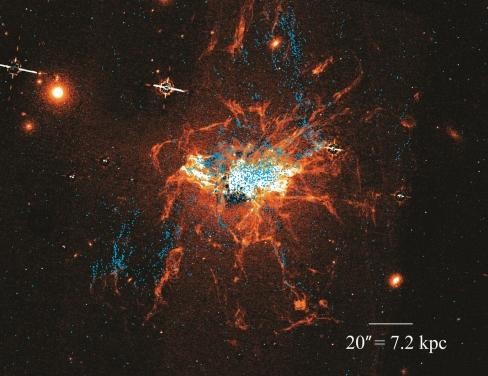

A study led by Dr Jeremy Lim and his Research Assistant, Miss Emily Wong, at the Department of Physics of The University of Hong Kong (HKU), utilizing data from the Hubble Space Telescope, has provided surprising answers to the origin of some globular clusters around giant galaxies at the centers of galaxy clusters. Conducted in collaboration with Professor Thomas Broadhurst at the Ikerbasque in Spain and a Visiting Research Professor at the HKU Department of Physics, Dr Youichi Ohyama at the Academia Sinica Institute of Astronomy & Astrophysics in Taiwan, and Dr Elinor Medizinski at Princeton University in the USA, their work is reported in the journal paper "Sustained Formation of Progenitor Globular Clusters in a Giant Elliptical Galaxy" published recently on the Nature Astronomy website.
Globular clusters are the oldest visible objects in the Universe - each contains hundreds of thousands to occasionally over ten million stars all born at essentially the same time, and densely packed into a spherical volume with diameter over a thousand times smaller than the diameter of our Galaxy. Globular clusters are thought to have formed soon after the Universe began nearly 13.8 billion years ago, at the same time as, or perhaps even before, the first galaxies formed. They have since remained largely unchanged, apart from the ageing and death of their constituent stars. As ancient, pristine witnesses to the formation of galaxies, globular clusters might provide vital clues to how infant galaxies form and then grow over time - if only we knew how globular clusters themselves form and accumulate around galaxies. Our Galaxy is surrounded by about 150 such globular clusters, some of which are visible to the naked eye from a sufficiently dark site. Bigger galaxies are surrounded by even more globular clusters. The largest numbers of globular clusters, over ten to twenty thousand, are found around giant galaxies at the centers of galaxy clusters. Galaxy clusters contain hundreds to thousands of galaxies bound together by gravity, and are infused by hot gas (up to ten times hotter than the center of the Sun) that far outweighs all the stars in the galaxies comprising the galaxy cluster combined.
They research team led by Dr Lim discovered that globular clusters around the giant galaxy at the center of the Perseus galaxy cluster are not all ancient objects: rather, a few thousand have formed over at least the past 1 billion years, and perhaps many more over the course of cosmic history. As shown in the accompanying picture, the younger globular clusters are closely associated with, and were therefore born in, a complex filamentary network of cool gas that extends to the outer reaches of the giant galaxy. This cool gas is thought to have precipitated from the hot gas that infuses the entire Perseus galaxy cluster; the density of the hot gas and hence the rate at which this gas cools rises rapidly towards the center of the galaxy cluster. After they form, the infant globular clusters are no longer bound to the network of cool gas and rain inwards onto the giant galaxy, like raindrops condensing and falling from clouds. By contrast, as shown also in the accompanying picture, the older globular clusters are distributed at random around the giant galaxy, owing to random scatterings off each other during their orbits around the giant galaxy.
This remarkable discovery explains a number of puzzling aspects about globular clusters around giant galaxies. First is their sheer numbers: evidently, some fraction of globular clusters around giant galaxies formed over cosmic history from the gas that infuses galaxy clusters. Second is the especially broad range of colors exhibited by globular clusters around giant galaxies: the colors of globular clusters change progressively from blue to red as they age (because more massive and bluer stars die first, leaving less massive and redder stars), and hence their broad range of ages results in a broad range of colors.
The globular clusters that formed from the network of cool gas at the center of the Perseus galaxy cluster span a broad range of masses, but with a diminishing number at higher masses. Their number dependence with mass follows the same trend as the truly ancient globular clusters, as well as less massive star clusters in our Galaxy and other spiral galaxies - thus affirming a common formation mechanism for star clusters over all mass scales (from those weighing just over ten Suns to those weighing about ten million Suns) irrespective of the environment in which they formed, whether it be from gas compressed in the spiral arms of galaxies or dense gas at the centers of galaxy clusters; or in ways yet to be discovered as is the case for truly ancient globular clusters.
The sustained formation of globular clusters at the centers of galaxy clusters helps explain another puzzling aspect of giant galaxies - their enormous sizes, up to ten times or more that of our Galaxy. Whereas the more massive globular clusters will long endure, the less massive globular clusters are expected to be ripped apart as they orbit the galaxy: their constituent stars, spread throughout the giant galaxy at the center of the galaxy cluster, contribute to the growth in size of these galaxies over time.
© 2025 NatureWorldNews.com All rights reserved. Do not reproduce without permission.





